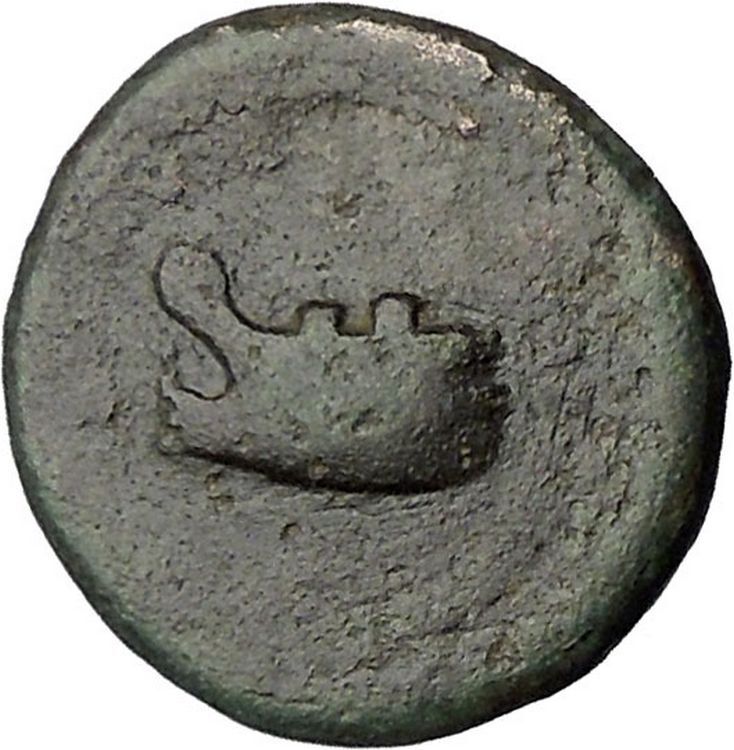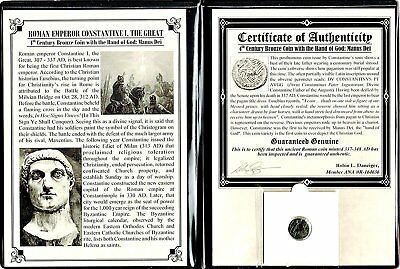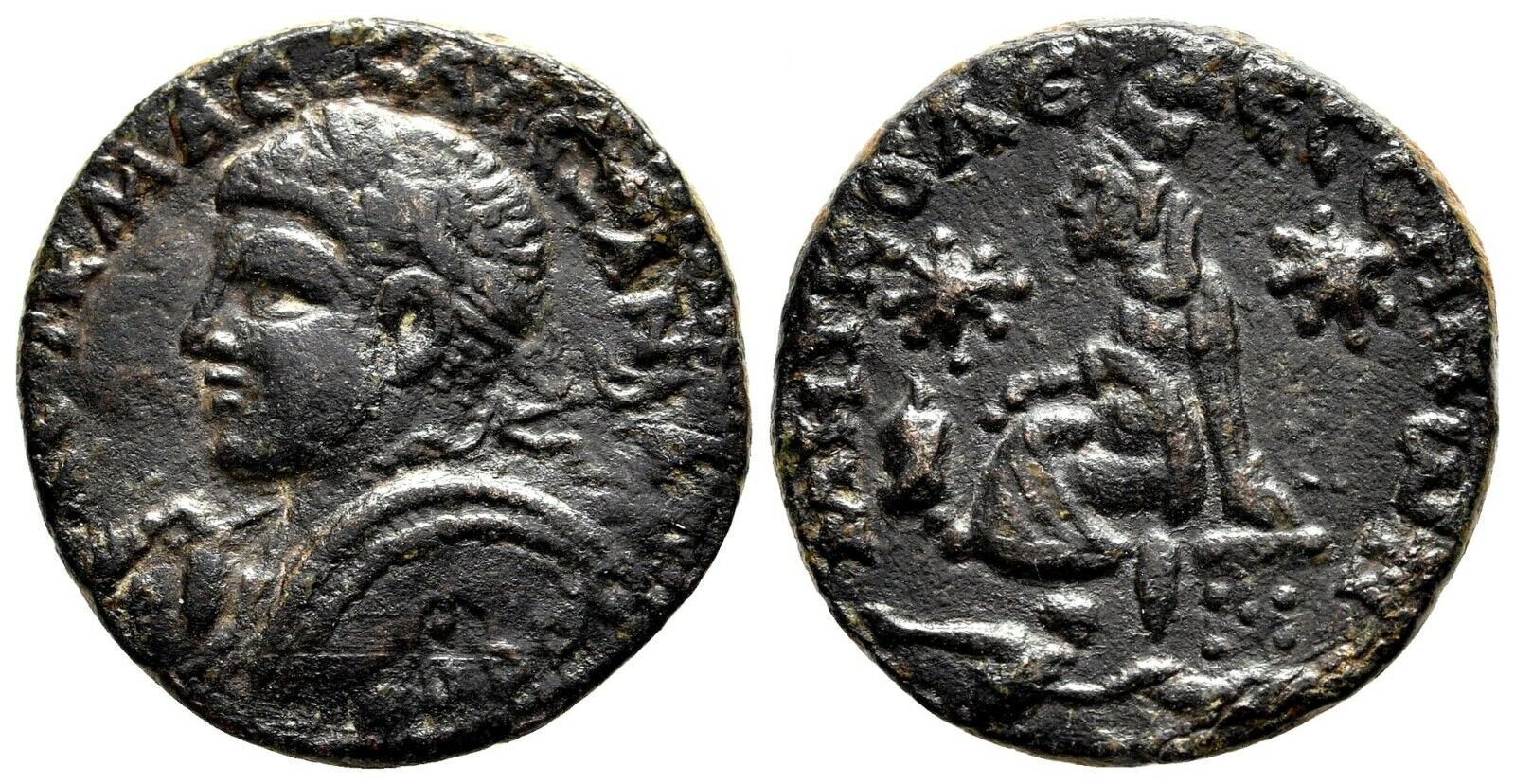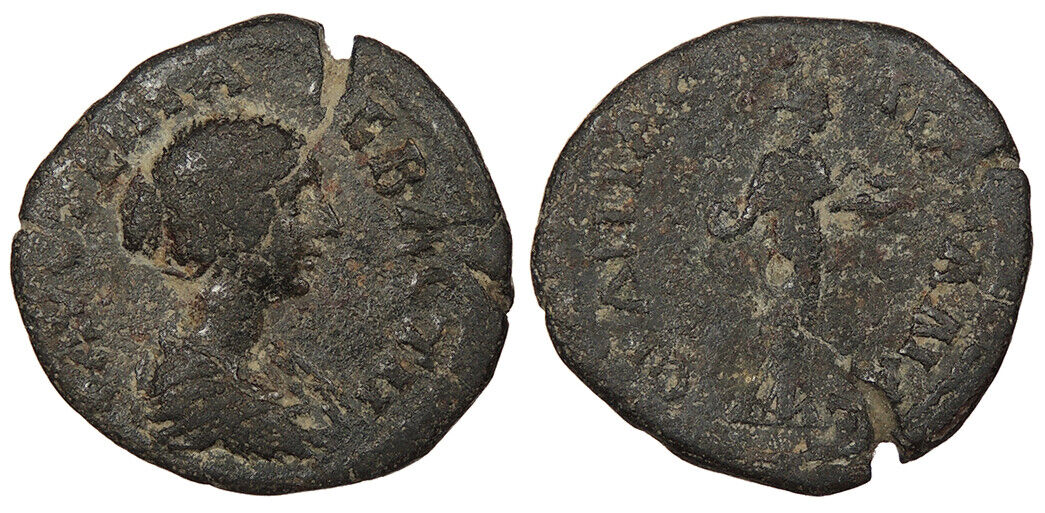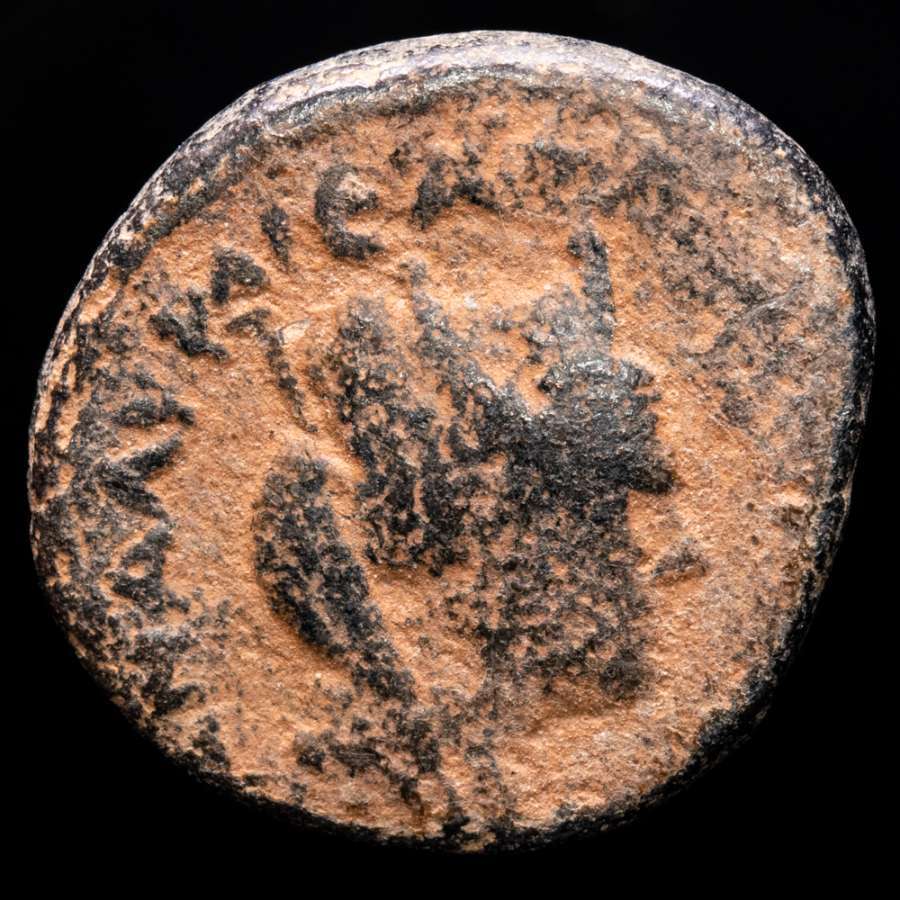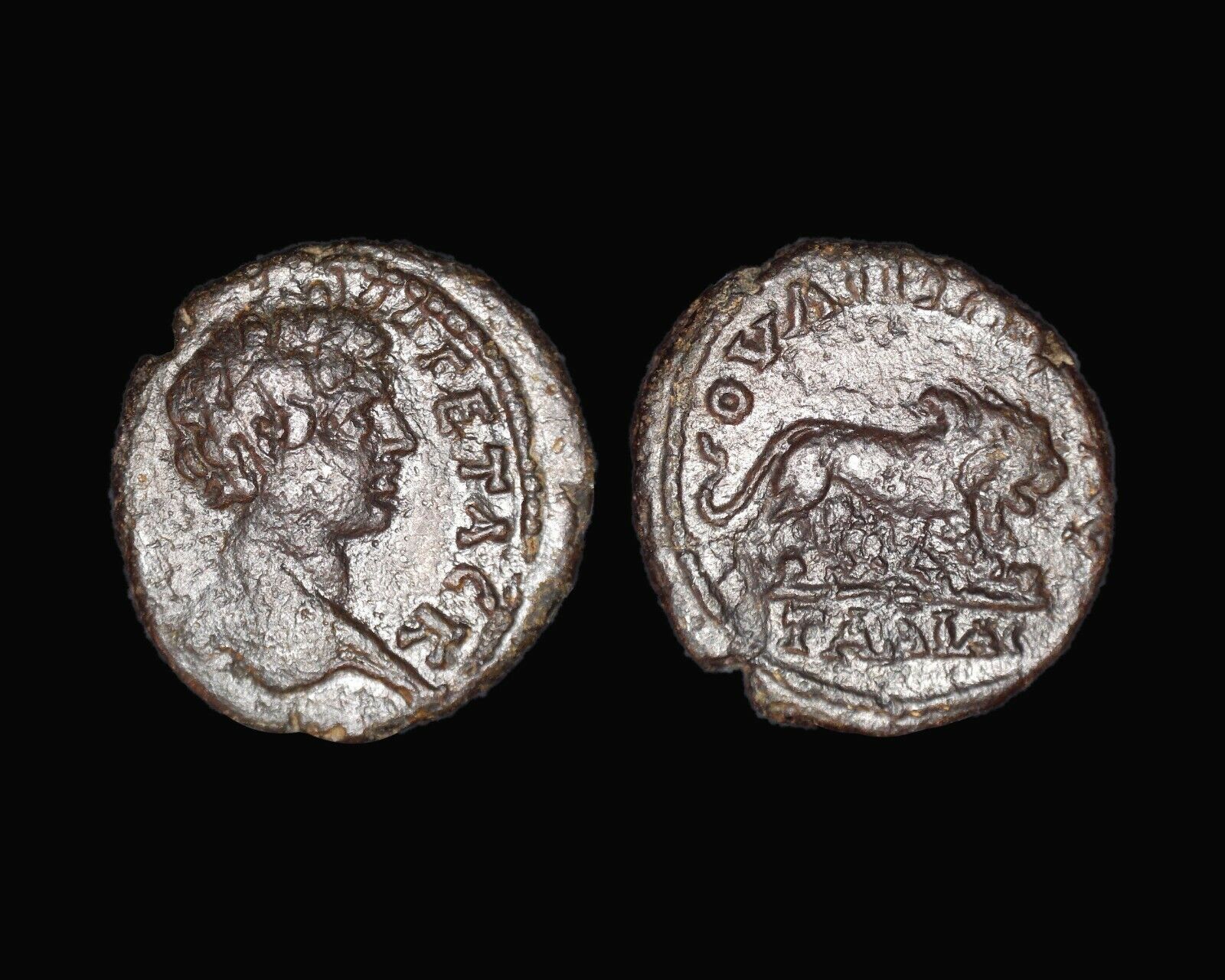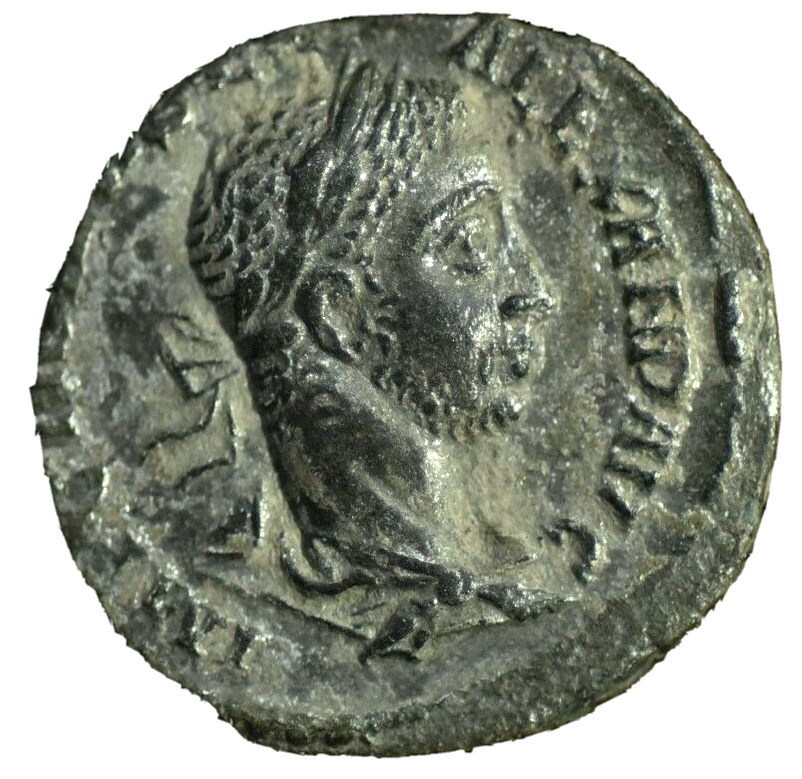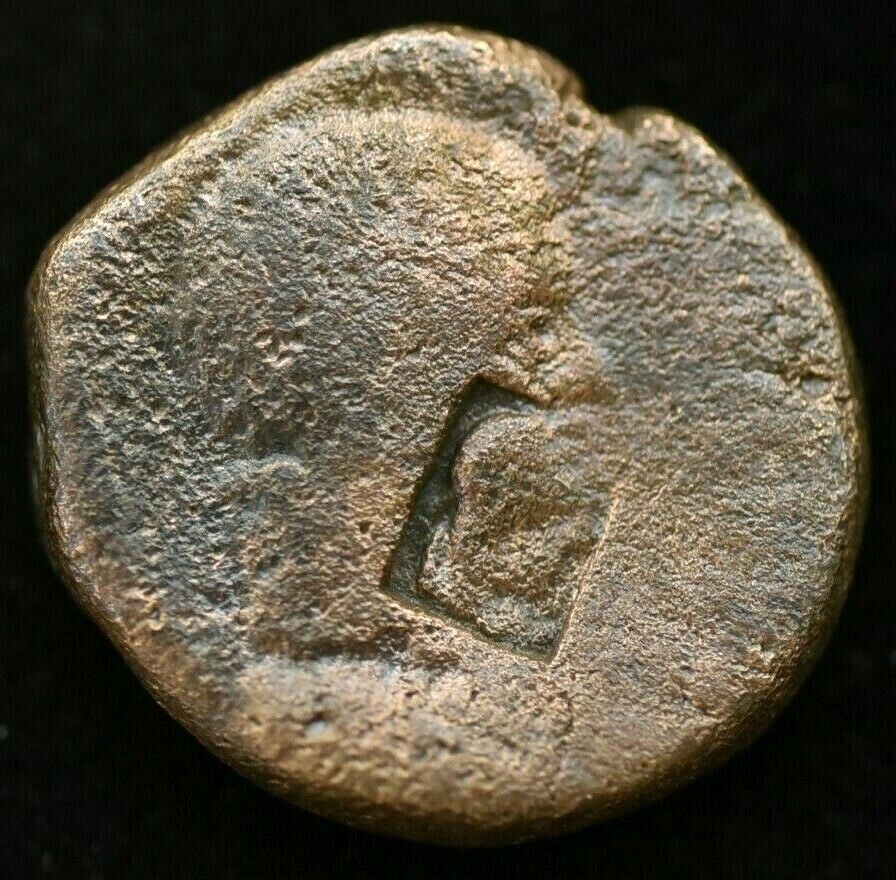-40%
CARACALLA 198AD Coela Thrace GALLEY Ship Authentic Ancient Roman Coin i48729
$ 26.4
- Description
- Size Guide
Description
Item:i48729
Authentic Ancient Coin of:
Caracalla
-
Roman Emperor
: 198-217 A.D. -
Bronze 19mm (3.77 grams) of
Coela in
Thrace
Laureate bust right.
Prow of galley left.
You are bidding on the exact item pictured, provided with a Certificate of Authenticity and Lifetime Guarantee of Authenticity.
A
galley
is a type of
ship
propelled by
rowers
that originated in the eastern
Mediterranean Sea
and was used for
warfare
,
trade
and
piracy
from the first millennium BC. Galleys dominated
naval warfare
in the Mediterranean from the 8th century BC until development of advanced sailing warships in the 17th century. Galleys fought in the wars of
Assyria
, ancient
Phoenicia
,
Greece
,
Carthage
and
Rome
until the 4th century AD. After the fall of the
Western Roman Empire
galleys formed the mainstay of the
Byzantine navy
and other navies of successors of the Roman Empire, as well as new
Muslim
navies. Medieval Mediterranean states, notably the Italian maritime republics, including
Venice
,
Pisa
,
Genoa
and the
Ottoman Empire
relied on them as the primary warships of their fleets until the 17th century, when they were gradually replaced by sailing warships. Galleys continued to be applied in minor roles in the Mediterranean and the
Baltic Sea
even after the introduction of
steam propelled
ships in the early 19th century.
The galley engagements at
Actium
and
Lepanto
are among the greatest
naval battles
in history.
Coela was located on the eastern part of the Thracian Chersonese, known in modern times as the Gallipoli Peninsula. It struck coins during times of Alexander the Great and later issued coins under the ancient Romans (known as Roman Provincial or Greek Imperial coins.
The
Gallipoli
peninsula
(
Turkish
:
Gelibolu
Yarımadası
;
Greek
:
Καλλίπολη
) is located in Turkish Thrace (or
East Thrace
), the European part of
Turkey
, with the
Aegean Sea
to the west and the
Dardanelles
strait to the east.
Gallipoli derives its name from the
Greek
"Καλλίπολις" (
Kallipolis
), meaning "Beautiful City". In
antiquity
, it was known as the
Thracian Chersonese
, from
Greek
:
Θρακική Χερσόνησος
(
Latin
:
Chersonesus Thracica
).
The peninsula runs in a south-westerly direction into the
Aegean Sea
, between the Hellespont (now known as the
Dardanelles
) and the bay of Melas (today
Saros bay
). Near
Agora
it was protected by a wall running across its full breadth. The isthmus traversed by the wall was only 36
stadia
in breadth (about 6.5 km), but the length of the peninsula from this wall to its southern extremity, Cape Mastusia, was 420 stadia (about 77.5 km).
Thrace
(demonym
Thracian
;
Bulgarian
:
Тракия,
Trakiya
,
Greek
:
Θράκη,
Thráki
,
Turkish
:
Trakya
) is a historical and geographic area in southeast
Europe
. As a geographical concept, Thrace designates a region bounded by the
Balkan Mountains
on the north,
Rhodope Mountains
and the
Aegean Sea
on the south, and by the
Black Sea
and the
Sea of Marmara
on the east. The areas it comprises are southeastern
Bulgaria
(
Northern Thrace
), northeastern
Greece
(
Western Thrace
), and the European part of
Turkey
(
Eastern Thrace
). The biggest part of Thrace is part of present-day Bulgaria. In Turkey, it is also called
Rumelia
. The name comes from the
Thracians
, an ancient
Indo-European
people inhabiting Southeastern Europe.
The historical boundaries of Thrace have varied. Noteworthy is the fact that, at an early date, the
ancient Greeks
employed the term "Thrace" to refer to all of the territory which lay north of
Thessaly
inhabited by the
Thracians
, a region which "had no definite boundaries" and to which other regions (like
Macedonia
and even
Scythia
) were added. In one ancient Greek source, the very Earth is divided into "Asia, Libya, Europa and Thracia". As the knowledge of world geography of the Greeks broadened, the term came to be more restricted in its application: Thrace designated the lands bordered by the
Danube
on the north, by the Euxine Sea (Black Sea) on the east, by northern
Macedonia
in the south and by the
Illyrian
lands (i.e.
Illyria
) to the west. This largely coincided with the Thracian
Odrysian kingdom
, whose borders varied in time. During this time, specifically after the Macedonian conquest, the region's old border with Macedonia was shifted from the
Struma River
to the
Mesta River
. This usage lasted until the Roman conquest. Henceforth, (classical) Thrace referred only to the tract of land largely covering the same extent of space as the modern geographical region. In its early period, the
Roman province of Thrace
was of this extent, but after the administrative reforms of the late 3rd century, Thracia's much reduced territory became the six small provinces which constituted the
Diocese of Thrace
. The medieval
Byzantine
theme
of
Thrace
contained only what today is
Eastern Thrace
.
The largest cities of Thrace are:
İstanbul
(European side),
Plovdiv
,
Burgas
,
Stara Zagora
,
Haskovo
,
Edirne
,
Çorlu
and
Tekirdag
.
Most of the Bulgarian and Greek population are Christians, while most of the Turkish inhabitants of Thrace are Muslims.
The Roman province of Thrace
Thrace in ancient Greek mythology
Ancient Greek mythology
provides them with a mythical ancestor, named
Thrax
, son of the war-god
Ares
, who was said to reside in Thrace. The Thracians appear in
Homer
's
Iliad
as
Trojan
allies, led by
Acamas
and
Peiros
. Later in the
Iliad
,
Rhesus
, another Thracian king, makes an appearance.
Cisseus
, father-in-law to the Trojan elder
Antenor
, is also given as a Thracian king. Homeric Thrace was vaguely defined, and stretched from the River
Axios
in the west to the
Hellespont
and
Black Sea
in the east. The
Catalogue of Ships
mentions three separate contingents from Thrace: Thracians led by Acamas and Peiros, from
Aenus
;
Cicones
led by
Euphemus
, from southern Thrace, near
Ismaros
; and from the city of
Sestus
, on the Thracian (northern) side of the Hellespont, which formed part of the contingent led by
Asius
. Greek mythology is replete with Thracian kings, including
Diomedes
,
Tereus
,
Lycurgus
,
Phineus
,
Tegyrius
,
Eumolpus
,
Polymnestor
,
Poltys
, and
Oeagrus
(father of
Orpheus
). In addition to the tribe that Homer calls Thracians, ancient Thrace was home to numerous other tribes, such as the
Edones
,
Bisaltae
,
Cicones
, and
Bistones
.
Thrace is also mentioned in Ovid's Metamorphoses in the episode of
Philomela
, Procne, and
Tereus
. Tereus, the King of Thrace, lusts after his sister-in-law, Philomela. He kidnaps her, holds her captive, rapes her, and cuts out her tongue. Philomela manages to get free, however. She and her sister, Procne, plot to get revenge, by killing Itys (son of Tereus and Procne) and serving him to his father for dinner. At the end of the myth, all three turn into birds—Procne, a swallow; Philomela, a nightingale; and Tereus, a
hoopoe
.
History
Ancient history
The indigenous population of Thrace was a people called the
Thracians
, divided into numerous tribal groups. Thracian troops were known to accompany neighboring ruler
Alexander the Great
when he crossed the
Hellespont
which abuts Thrace, and took on the
Persian Empire
of the day.
The Thracians did not describe themselves as such and
Thrace
and
Thracians
are simply the names given them by the Greeks.
Divided into separate tribes, the Thracians did not manage to form a lasting political organization until the
Odrysian state
was founded in the 4th century BC. Like
Illyrians
, Thracian tribes of the mountainous regions fostered a locally ruled warrior tradition, while the tribes based in the plains were purportedly more peaceable. Recently discovered funeral mounds in Bulgaria suggest that Thracian kings did rule regions of Thrace with distinct Thracian national identity.
During this period, a subculture of
celibate
ascetics
called the
Ctistae
lived in Thrace, where they served as philosophers, priests and prophets.
Medieval history
By the mid 5th century, as the Roman Empire began to crumble, Thracia fell from the authority of Rome and into the hands of Germanic tribal rulers. With the fall of Rome, Thracia turned into a battleground territory for the better part of the next 1,000 years. The eastern successor of the
Roman Empire
in the Balkans, the
Byzantine Empire
, retained control over Thrace until the 8th century when the northern half of the entire region was incorporated into the
First Bulgarian Empire
. Byzantium regained Thrace in the late 10th century and administered it as a
theme
, until the Bulgarians regained control of the northern half at the end of the 12th century. Throughout the 13th century and the first half of the 14th century, the region was changing in the hands of the Bulgarian and the Byzantine Empire(excl. Constantinopole). In 1265 the area suffered a Mongol raid from the
Golden Horde
, led by
Nogai Khan
. In 1352, the
Ottoman
Turks
Caracalla 198-217 A.D.
Caesar: 195-198 A.D. (under
<="" font="" color="#000000" face="Times New Roman">
Septimius Severus
)
Augustus: 198-217 A.D. (198-209 A.D. with
<="" font="" color="#000000" face="Times New Roman">
Septimius Severus
) (209-211 A.D. with
<="" font="" color="#000000" face="Times New Roman">
Septimius Severus
and
Geta
) (211 A.D. with
Geta
) (211-217 A.D. Sole Reign)
Son of
<="" font="" color="#000000" face="Times New Roman">
Septimius Severus
and
<="" font="" color="#000000" face="Times New Roman">
Julia Domna
| Brother of
Geta
| Husband of
<="" font="" color="#000000">
Plautilla
="">
| Nephew of
<="" font="" color="#000000">
Julia Maesa
="">
| Cousin of
<="" font="" color="#000000" face="Times New Roman">
Julia Soaemias
and
<="" font="" color="#000000" face="Times New Roman">
Julia Mamaea
|
Caracalla
(
Latin
:
Marcus Aurelius Severus Antoninus Augustus
;4 April 188 – 8 April 217) was
Roman emperor
from 198 to 217 The eldest son of
Septimius Severus
, for a short time he ruled jointly with his younger brother
Geta
until he had him murdered in 211. Caracalla is remembered as one of the most notorious and unpleasant of emperors because of the massacres and persecutions he authorized and instigated throughout the Empire.
Caracalla's reign was also notable for the
Constitutio Antoniniana
(also called the Edict of Caracalla), granting
Roman citizenship
to all freemen throughout the
Roman Empire
, which according to historian
Cassius Dio
, was done for the purposes of raising tax revenue. He is also one of the emperors who commissioned a large public bath-house (
thermae
) in Rome. The remains of the
Baths of Caracalla
are still one of the major tourist attractions of the Italian capital.
Early life
Caracalla, of mixed
Punic
–
Roman
and
Syrian
descent, was born Lucius Septimius Bassianus in
Lugdunum
,
Gaul
(now
Lyon
,
France
), the son of the later Emperor Septimius Severus and
Julia Domna
. At the age of seven, his name was changed to Marcus Aurelius Septimius Bassianus Antoninus to create a connection to the family of the philosopher emperor
Marcus Aurelius
. He was later given the
Caracalla
nickname
, which referred to the Gallic hooded tunic he habitually wore and which he made fashionable.
Reign (211)
Murder of brother (211)
His father died in 211 at
Eboracum
(now
York
) while on campaign in northern Britain. Caracalla was present and was then proclaimed emperor by the troops along with his brother
Publius Septimius Antoninus Geta
. Caracalla suspended the
campaign in Caledonia
and soon ended all military activity, as both brothers wanted to be sole ruler thus making relations between them increasingly hostile. When they tried to rule the Empire jointly they actually considered dividing it in halves, but were persuaded not to do so by their mother.
Then in December 211 at a reconciliation meeting arranged by their mother Julia, Caracalla had Geta assassinated by members of the Praetorian Guard loyal to himself, Geta dying in his mother's arms. Caracalla then persecuted and executed most of Geta's supporters and ordered a
damnatio memoriae
pronounced by the Senate against his brother's memory.
Geta's image was simply removed from all coinage, paintings and statues, leaving a blank space next to Caracalla's. Among those executed were his former cousin-wife
Fulvia Plautilla
, his unnamed daughter with Plautilla along with her brother and other members of the family of his former father-in-law
Gaius Fulvius Plautianus
. Plautianus had already been executed for alleged treachery against emperor Severus in 205.
About the time of his accession he ordered the
Roman currency
devalued, the silver purity of the
denarius
was decreased from 56.5% to 51.5%, the actual silver weight dropping from 1.81 grams to 1.66 grams – though the overall weight slightly increased. In 215 he introduced the
antoninianus
, a "double denarius" weighing 5.1 grams and containing 2.6 grams of silver – a purity of 52%.
In the Roman provinces
In 213, Caracalla went north to the German frontier to deal with the
Alamanni
tribesmen who were raiding in the
Agri Decumates
. The Romans did defeat the Alamanni in battle near the river
Main
, but failed to win a decisive victory over them. After a peace agreement was brokered and a large bribe payment given to the invaders, the Senate conferred upon him the empty title of
Germanicus Maximus
. He also acquired the surname
Alemannicus
at this time. The following year the tyrant traveled to the East, to Syria and Egypt never to return to Rome.
Gibbon
in his work describes Caracalla as "the common enemy of mankind". He left the capital in 213, about a year after the murder of Geta, and spent the rest of his reign in the provinces, particularly those of the East. He kept the Senate and other wealthy families in check by forcing them to construct, at their own expense, palaces, theaters, and places of entertainment throughout the periphery. New and heavy taxes were levied against the bulk of the population, with additional fees and confiscations targeted at the wealthiest families.
When the inhabitants of
Alexandria
heard Caracalla's claims that he had killed Geta in self-defense, they produced a satire mocking this as well as Caracalla's other pretensions. In 215, Caracalla savagely responded to this insult by slaughtering the deputation of leading citizens who had unsuspectingly assembled before the city to greet his arrival, and then unleashed his troops for several days of looting and plunder in Alexandria. According to historian Cassius Dio, over 20,000 people were killed.
[
citation needed
]
Domestic Roman policy
Affiliation with the army
During his reign as emperor, Caracalla raised the annual pay of an average legionary to 675
denarii
and lavished many benefits on the army which he both feared and admired, as instructed by his father Septimius Severus who had told him on his deathbed to always mind the soldiers and ignore everyone else. Caracalla did manage to win the trust of the military with generous pay rises and popular gestures, like marching on foot among the ordinary soldiers, eating the same food, and even grinding his own flour with them.
With the soldiers, "He forgot even the proper dignity of his rank, encouraging their insolent familiarity," according to Gibbon. "The vigour of the army, instead of being confirmed by the severe discipline of the camps, melted away in the luxury of the cities."
His official portraiture marks a break with the detached images of the philosopher–emperors who preceded him: his close-cropped haircut is that of a soldier, his pugnacious scowl a realistic and threatening presence. This rugged soldier–emperor iconic archetype was adopted by most of the following emperors who depended on the support of the troops to rule, like his eventual successor
Maximinus Thrax
.
Seeking to secure his own legacy, Caracalla also commissioned one of Rome's last major architectural achievements, the
Baths of Caracalla
, the 2nd largest public baths ever built in ancient Rome. The main room of the baths was larger than
St. Peter's Basilica
, and could easily accommodate over 2,000 Roman citizens at one time. The bath house opened in 216, complete with libraries, private rooms and outdoor tracks. Internally it was lavishly decorated with gold-trimmed marble floors, columns, mosaics and colossal statuary.
Edict of Caracalla (212)
The
Constitutio Antoniniana
(Latin: "Constitution [or Edict] of Antoninus") (also called
Edict of Caracalla
) was an edict issued in 212 by Caracalla which declared that all free men in the Roman Empire were to be given full Roman citizenship and all free women in the Empire were given the same rights as Roman women.
Before 212, for the most part only inhabitants of Italia held full Roman citizenship. Colonies of Romans established in other provinces, Romans (or their descendants) living in provinces, the inhabitants of various cities throughout the Empire, and small numbers of local nobles (such as kings of client countries) held full citizenship also. Provincials, on the other hand, were usually non-citizens, although many held the
Latin Right
.
The Roman Historian
Cassius Dio
contended that the sole motivation for the edict was a desire to increase state revenue.At the time aliens did not have to pay most taxes that were required of citizens, so although nominally Caracalla was elevating their legal status, he was more importantly expanding the Roman tax base. The effect of this was to remove the distinction that citizenship had held since the foundation of Rome and as such the act had a profound effect upon the fabric of Roman society.
War with Parthia
According to the historian Herodian, in 216, Caracalla tricked the Parthians into believing that he accepted a marriage and peace proposal, but then had the bride and guests slaughtered after the wedding celebrations. The thereafter ongoing conflict and skirmishes became known as the
Parthian war of Caracalla
.
Assassination (217)
The Roman Empire during the reign of Caracalla.
While travelling from
Edessa
to continue the war with
Parthia
, he was assassinated while urinating at a roadside near
Carrhae
on 8 April 217 (4 days after his 29th birthday), by Julius Martialis, an officer of his personal bodyguard.
Herodian
says that Martialis' brother had been executed a few days earlier by Caracalla on an unproven charge; Cassius Dio, on the other hand, says that Martialis was resentful at not being promoted to the rank of centurion. The escort of the emperor gave him privacy to relieve himself, and Martialis then ran forward and killed Caracalla with a single sword stroke. While attempting to flee, the bold assassin was then quickly dispatched by a Scythian archer of the Imperial Guard.
Caracalla was succeeded by his
Praetorian Guard Prefect
,
Macrinus
, who (according to Herodian) was most probably responsible for having the emperor assassinated.
His nickname
According to
Aurelius Victor
in his
Epitome de Caesaribus
, the
agnomen
"Caracalla" refers to a Gallic
cloak
that Caracalla adopted as a personal fashion, which spread to his army and his court. Cassius Dio and the
Historia Augusta
agree that his nickname was derived from his cloak, but do not mention its country of origin.
Legendary king of Britain
Geoffrey of Monmouth
's legendary
History of the Kings of Britain
makes Caracalla a king of Britain, referring to him by his actual name "Bassianus", rather than the nickname Caracalla. In the story, after Severus's death the Romans wanted to make Geta king of Britain, but the Britons preferred Bassianus because he had a British mother. The two brothers fought a battle in which Geta was killed and Bassianus succeeded to the throne. He ruled until he was betrayed by his
Pictish
allies and overthrown by
Carausius
, who, according to Geoffrey, was a Briton, rather than the historically much later
Menapian
Gaul that he actually was.
="">="">="">="">="">="">="">
Frequently Asked Questions
How long until my order is shipped?
Depending on the volume of sales, it may take up to 5 business days for shipment of your order after the receipt of payment.
How will I know when the order was shipped?
After your order has shipped, you will be left positive feedback, and that date should be used as a basis of estimating an arrival date.
After you shipped the order, how long will the mail take?
USPS First Class mail takes about 3-5 business days to arrive in the U.S., international shipping times cannot be estimated as they vary from country to country. I am not responsible for any USPS delivery delays, especially for an international package.
What is a certificate of authenticity and what guarantees do you give that the item is authentic?
Each of the items sold here, is provided with a Certificate of Authenticity, and a Lifetime Guarantee of Authenticity, issued by a world-renowned numismatic and antique expert that has identified over 10000 ancient coins and has provided them with the same guarantee. You will be quite happy with what you get with the COA; a professional presentation of the coin, with all of the relevant information and a picture of the coin you saw in the listing.
Compared to other certification companies, the certificate of authenticity is a -50 value. So buy a coin today and own a piece of history, guaranteed.
Is there a money back guarantee?
I offer a 30 day unconditional money back guarantee. I stand behind my coins and would be willing to exchange your order for either store credit towards other coins, or refund, minus shipping expenses, within 30 days from the receipt of your order. My goal is to have the returning customers for a lifetime, and I am so sure in my coins, their authenticity, numismatic value and beauty, I can offer such a guarantee.
Is there a number I can call you with questions about my order?
You can contact me directly via ask seller a question and request my telephone number, or go to my About Me Page to get my contact information only in regards to items purchased on eBay.
When should I leave feedback?
Once you receive your order, please leave a positive. Please don't leave any negative feedbacks, as it happens many times that people rush to leave feedback before letting sufficient time for the order to arrive. Also, if you sent an email, make sure to check for my reply in your messages before claiming that you didn't receive a response. The matter of fact is that any issues can be resolved, as reputation is most important to me. My goal is to provide superior products and quality of service.
